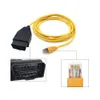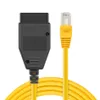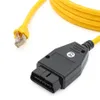Are you a BMW F-Series owner looking for precise diagnostics and programming? Look no further than the ENET cable. This innovative tool enables faster data transfer speeds, more accurate diagnostics, and more efficient programming for your vehicle. Compatible with a variety of BMW F-Series models, using the ENET cable is easy and effective. Say goodbye to unreliable diagnostic tools and hello to the precision of the ENET cable. Upgrade your vehicle’s performance today.








ENET Cable
If you’re the owner of a BMW F-Series vehicle, you know that precise diagnostics and programming are essential to keeping your car running smoothly. That’s where an ENET cable comes in. In this article, we’ll explain what an ENET cable is and how it enables accurate diagnostics and programming for BMW F-Series vehicles.
What is an ENET Cable?
An ENET cable is a diagnostic tool that is used with BMW’s proprietary software, ISTA+. This software allows technicians to diagnose and program all modules within the vehicle, including the engine control module (ECM), transmission control module (TCM), and more. The ENET cable connects directly to the OBD-II port on your BMW, providing a reliable and secure link between the vehicle and the technician’s computer.
Why is an ENET Cable So Important?
Without an ENET cable, technicians would be unable to access the advanced diagnostic and programming features of ISTA+. This would limit their ability to accurately diagnose problems and make necessary repairs to your vehicle. Additionally, using a generic OBD-II scanner can often result in incomplete or inaccurate readings which can lead to further complications down the line. An ENET cable ensures that the technician is receiving accurate data from the vehicle, allowing for more precise and efficient repairs.
How Does an ENET Cable Work?
When connected to the vehicle’s OBD-II port, the ENET cable establishes a direct connection between the vehicle and the technician’s computer. This connection allows the technician to access the vehicle’s onboard computer system and run various diagnostics tests. Additionally, the technician can use ISTA+ to reprogram the vehicle’s modules as needed. This can include updating the vehicle’s firmware, modifying certain settings, and even adding new features to the vehicle.
Benefits of ENET Cable
ENET cables have gained popularity among automotive enthusiasts due to their many benefits. For starters, they offer faster data transfer speeds than traditional OBD-II cables. With an ENET cable, data can be transferred at a rate of up to 100 Mbps, whereas OBD-II cables typically transfer data at only 10.4 Kbps. This increase in speed allows for quicker diagnostics and programming, ultimately saving time and increasing efficiency.
Another benefit of ENET cables is their ability to provide more accurate diagnostics. By connecting a laptop or other device directly to the vehicle’s diagnostic port using an ENET cable, users can access detailed information about the car’s systems and components. This includes fault codes, sensor readings, and other diagnostic data that may not be available through standard OBD-II scanners. This level of detail allows for more precise troubleshooting and repair, reducing the risk of misdiagnosis and costly repairs.
In addition to diagnostics, ENET cables also allow for more efficient programming. With the ability to transfer large amounts of data quickly, programming updates can be completed in a fraction of the time it would take using traditional methods. This is especially useful for those who frequently update their vehicle’s software, as it saves both time and money.
ENET cables also offer greater flexibility compared to traditional OBD-II cables. While OBD-II cables are limited to a specific set of protocols, ENET cables can be used with various protocols and software programs. This makes them a versatile tool for any BMW F-Series owner or mechanic.
Compatibility
The BMW F-Series models compatible with the ENET cable include the F01, F02, F06, F07, F10, F11, F12, F13, F15, F16, F20, F21, F22, F23, F25, F26, F30, F31, F32, F33, F34, F35, F36, F45, F46, F48, F49, F52, F54, F55, F56, F57, F60, and G01. These models are fitted with Ethernet ports, which facilitate communication with the ECUs.
To use the ENET cable properly, follow these steps:
1. Identify the OBD-II port in your vehicle. It is usually located under the dashboard on the driver’s side.
2. Connect one end of the ENET cable to the OBD-II port and the other end to your laptop or PC’s Ethernet port.
3. Turn on the ignition and start the engine.
4. Launch the diagnostic software application on your computer. Popular options include INPA, ISTA-D, and ISTA-P.
5. Follow the prompts on the application to establish a connection with your BMW’s ECUs.
6. Once connected, you can access various functions such as coding, programming, and fault diagnosis.
7. Always adhere to the manufacturer’s instructions and guidelines when using the ENET cable. Avoid any unauthorized modifications or alterations that may void the warranty or compromise the integrity of your vehicle’s systems.
In conclusion, the compatibility of your ENET cable with your BMW F-Series model is vital for effective communication with the ECUs. By following the above steps, you can use the ENET cable correctly and carry out essential functions such as coding, programming, and fault diagnosis. Always prioritize safety and adhere to the manufacturer’s guidelines to ensure optimal performance and longevity of your vehicle.
FAQ
Q1. What is an ENET cable?
The ENET cable is a specialized tool used in BMW F-Series vehicles for precise diagnostics and programming. It is designed to efficiently transfer data between the vehicle’s computer system and external devices such as laptops or diagnostic equipment.
Q2. How does the ENET cable work?
The ENET cable works by connecting one end to the OBD-II port on the BMW F-Series vehicle and the other end to a laptop or diagnostic equipment. This allows for direct communication with the vehicle’s onboard computer system, enabling users to perform advanced diagnostics and programming tasks.
Q3. What are the benefits of using an ENET cable?
Using an ENET cable has several benefits, including faster data transfer speeds and increased accuracy and precision in diagnostic and programming tasks. Additionally, the ENET cable can be used to customize vehicle settings and features, allowing for a more personalized driving experience.
Q4. Is the ENET cable easy to use?
Yes, the ENET cable is designed to be user-friendly and easy to use, even for those with limited technical expertise. Simply connect the cable to the vehicle’s OBD-II port and your laptop or diagnostic equipment, and follow the instructions provided by the software. With practice, users can become proficient in performing advanced diagnostics and programming tasks with the ENET cable.